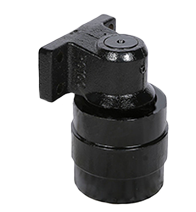Rubber track VS Steel track
Rubber tracks are ideal on grass or dirt, but in wet or muddy conditions, you’ll need a more aggressive tread pattern to avoid getting stuck; steel tracks offer more traction, especially on hills or uneven surfaces, but they leave their mark on almost every surface, even concrete.
The Difference Between Steel and Rubber Tracks
There’s more to the difference between rubber and steel tracks than their outward appearance. Yes, one track form has rubber-based construction, and the other is made with steel. But, it’s each form’s physical properties that give them an advantage or disadvantage over their crawling competitor.
Steel is a tough and durable material. It’s also heavy. That makes steel ideal for equipment that needs its track system to act as a counterweight and deliver a low center of gravity while working on harsh ground conditions.
Almost all steel used in today’s track manufacturing is recycled. But where steel excels as a track material is its linking ability. Steel tracks are a continuous chain of separate links that work together as a traction and weight distribution system.
Rubber tracks are also a continuous traction and weight transfer system. However, they are not separate links and have an Achilles Heel. If a steel link breaks, it can easily be removed and replaced. If a rubber track snaps, the whole assembly is ruined.
Are rubber tracks better than steel tracks?
Both steel and rubber tracks are highly mobile and provide excellent traction on most terrain. On relatively smooth, dry surfaces such as concrete, turf or asphalt, rubber tracks have the advantage. However steel tracks give superior traction on harsher terrain such as extremely rocky or wet, muddy terrain.
Can I put rubber tracks on a steel track excavator?
If you will be working on abrasive ground conditions and inclined terrains, consider installing steel tracks. Adaptability – You can bolt rubber pads onto the steel tracks to prevent damaging concrete, pavement, or sensitive surfaces.
Can I replace steel tracks with rubber tracks?
Converting from steel to rubber or vice versa can sometimes be problematic as many machines have different track spring tension settings between steel and rubber track machines and other machines run alternate sprockets, idlers or even rollers.
Tags :

Sign up to our newsletter for the construction machinery